

Metal detecting holidays in England with the World's most successful metal detecting club.20 years plus.
Twinned with Midwest Historical Research Society USA.
|
Silver
Groats (4 pence) page
|
|
The first English groats were copied from the Continental gros tournois and were issued during the reign of Edward I in 1279. This first issue of groats weighed 89 grains. The groat became more established after they were reissued in 1351 by Edward III with a lower weight of 72 grains. The design changed relatively little during the next 150 years although there was a reduction in weight to 60 grains in 1412 during the reign of Henry IV. It was reduced to 48 grains in 1464 during the reign of Edward IV. Eventually the design was changed in 1502 when a profile portrait of Henry VII was used. The first issues of Henry VIII continued to use the portrait of Henry VII from 1509 to 1526 when a new issue with his own portrait was made. From 1544 the fineness of the silver was steadily debased from the normal .925 fine down to .333 fine. During the reign of Edward VI the standard of the silver coinage was raised again but the groat was not struck to this new standard until the reign of Mary I. Elizabeth I had several developments during her reign. From 1559 to 1560 the groat was struck with a fineness of 0.916 and weighed 32 grains. In 1560 the fineness was increased further to 0.925 keeping the same weight. In 1561 a new issue was made but the groat was replaced by the sixpence and did not reappear. It is about this time that the word fourpence came to replace the word groat. The milled version of the groat was produced at the same time as the hammered issues by Eloi Mestrell. The hammered fourpence was issued for Maundy purposes until 1662 during the reign of Charles II. After 1662 a milled issue was made fairly regularly until the reign of George III. The crowned numeral first appeared in 1686 when the roman numeral IIII was used as a pun on Iacobus for James II. On the accession of William and Mary the arabic number 4 was used instead and the basic design has not changed since. After the reign of George III the crowned 4 type was issued exclusively for use in the Maundy ceremony and is still issued up until the present day although revalued as 4 new pence on decimalisation in 1971. |
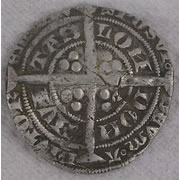  |
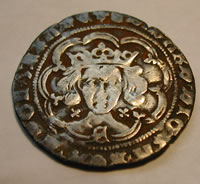 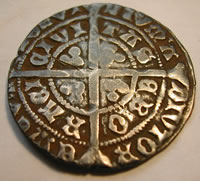 |
|
1351-2 Edward III hammered silver groat - Cross 1 Type F Obv EDWARD D G REX ANGL Z FRANC D HYB Rev POSVI DEVM ADIVTORE MEVM (outer) CIVITAS LONDON (Mint) (inner)
|
1351-2
Edward III groat - York mint(Civitas EboRaci)
|
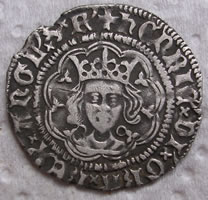  |
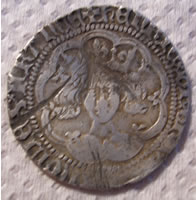 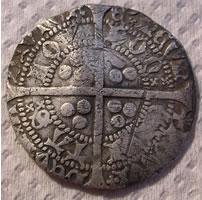 |
|
Henry
VI Annulet issue hammered silver half groat (1422-1427) Calais Mint
Standard F type JJ North 1429 Obv HENRIC
DI GRA REX ANGL Z FRANC DNS H |
1422-27
AD Henry VI hammered silver Groat - 3.59g, 25.29mm
|
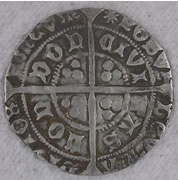  |
  |
|
1464 Edward IV First reign light coinage Type VI Very clear London, Initial mark sun on both sides, Quatrefoils at neck, Fleur on cusps except over crown 3.01g, 25.03mm obV EDWARD DI GRA REX ANGL Z FRANC rev CIVITAS LONDON |
1493-5 AD Henry VII Class 1 hammered silver groat (4 pence). 2.6g - 25.21mm |
  |
|
|
1526- 44 Henry VIII 2nd Profile issue London Mint Obverse shows reversed Roman D for C in HENRIC and in FRANC- Laker D hammered silver groat |
|
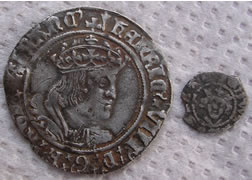  |
|
|
1532- 42 AD Henry VIII hammered silver groat - 2nd coinage 2.68g, 25.18mm and a 1272 AD Edward hammered silver farthing 0.32g,9.52mm - Type 30h Obv EDWARDVS REX AN Rev CIVITAS LONDON |
|
 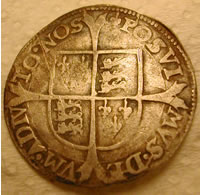 |
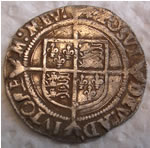 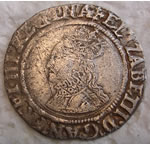 |
|
1553-58
Phillip and Mary hammered silver groat
|
1560-1
Elizabeth 1st hammered silver groat
|
  |
|
|
Irish 1605
James 1st hammered silver groat
|
|
|
Milled
silver groats
|
|
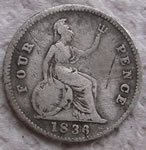 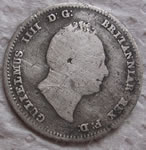 |
  |
|
1836
William IIII milled silver four pence (groat)
|
1843
Victorian milled silver four pence
|
